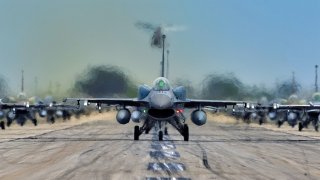Greek Fire Sale – Its Old F-16 Fighters End Up in Ukraine?
Greece is undertaking a substantial transformation of its air force, planning to decommission and sell parts of its diverse fleet, including F-16 and Mirage 2000 fighter jets, as part of its efforts to modernize and streamline military capabilities for the 21st century.
Summary: Greece is undertaking a substantial transformation of its air force, planning to decommission and sell parts of its diverse fleet, including F-16 and Mirage 2000 fighter jets, as part of its efforts to modernize and streamline military capabilities for the 21st century. Defense Minister Nikos Dendias emphasized the need for radical changes across the board, highlighting the unsustainable costs of maintaining a wide variety of aircraft. The transition includes upgrading remaining F-16s to the more advanced Viper configuration and expanding its Rafale fleet from 24 to 30 units. Additionally, Greece is looking to bolster its air force with 40 state-of-the-art F-35 Lightning IIs, pending U.S. Congressional approval. This overhaul not only aims to enhance Greece's defense posture but also presents opportunities for other nations, like Ukraine, which might acquire some of the decommissioned aircraft to strengthen their own military capabilities.
From F-16s to F-35s: Greece's Ambitious Plan to Modernize Its Air Combat Fleet
More than 4,600 F-16 Fighting Falcons have been produced and delivered to the United States and its allies. More than 25 nations have adopted the single-engine, supersonic multirole fighter, making it one of the most common fixed-wing aircraft in military service.
Among the nations that adopted the Fighting Falcon is NATO ally Greece, which is now upgrading its combat air fleet. Athens plans to decommission and sell its F-16s, as well as its Mirage 2000 fighter jets.
The move is meant to "prepare the armed forces for the 21st century," Greek Defense Minister Nikos Dendias said on March 25.
"We need to make some very radical changes, in the weapons systems, in the structure, in innovation – that is, in the ability to create new systems using our own capabilities – in the military service, in our own significant and motivated personnel, everything needs to change. Everything needs to change in order to maintain exactly the same goal: the ability to protect our sovereignty and independence," Dendias said.
He named the variety of aircraft in service with the Hellenic Air Force, and airframes included the F-4, Mirage 2000-5, Block 30 F-16s, Block 50 F-16s, Block 52 F-16s, Viper F-16s, and Rafales.

"We cannot carry on this way. The F-4s need to be retired and, if possible, sold. The Mirage 2000-5 is an exceptionally capable plane and can be sold. The Block 30 F-16s need to be sold," explained Dendias, who pointed to the enormous cost of maintaining so many different types of aircraft.
In the short term, Greece would upgrade its F-16s to the Viper level, while increasing from 24 to 30 the number of French-made Rafale fighters it flies.
The Hellenic Air Force will also be acquiring forty Block 4 F-35 Lightning IIs – bringing it into the 21st century. That deal was announced by the U.S. Department of State in January but is still pending Congressional approval.
A Potential Greek Fire Sale
This could be the largest reform program in the history of the modern Greek state, and Athens previously announced it would sell its eighteen Mirage 2000 fighters to India. It could be a different story for the forty F-16 Block 30 versions, as well as thel forty Block 50 aircraft.
According to The War Zone, the Block 30 F-16s include 34 single-seat F-16C and six F-16D variants. Those aircraft were procured under the Peace Xenia I Foreign Military Sales program and delivered between 1988 and 1990. It was previously suggested those aircraft could be used as aggressors for air defense training, but it now seems more likely that Athens will seek a foreign buyer. The aircraft might not have to fly far – Ukraine was quickly named as a potential destination.
Kyiv is already on track to receive around 40 Fighting Falcons from Denmark and the Netherlands, with the first aircraft expected to arrive this summer. An additional 40, and perhaps even as many as 80 fighters, could be significant for Ukraine. It might even be enough to tip the scales in its favor.
Author Experience and Expertise: Peter Suciu
Peter Suciu is a Michigan-based writer. He has contributed to more than four dozen magazines, newspapers, and websites with over 3,200 published pieces over a twenty-year career in journalism. He regularly writes about military hardware, firearms history, cybersecurity, politics, and international affairs. Peter is also a Contributing Writer for Forbes and Clearance Jobs. You can follow him on Twitter: @PeterSuciu. You can email the author: [email protected].


